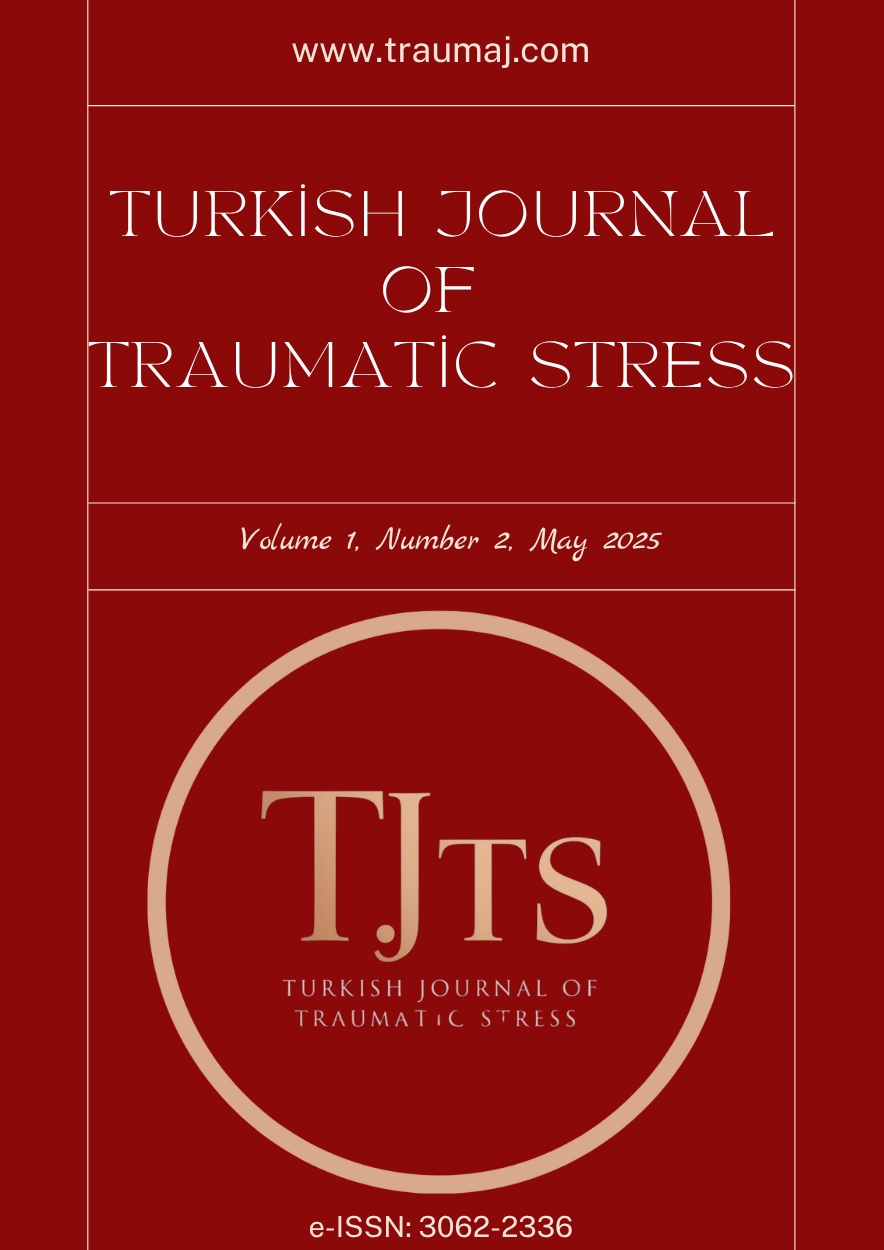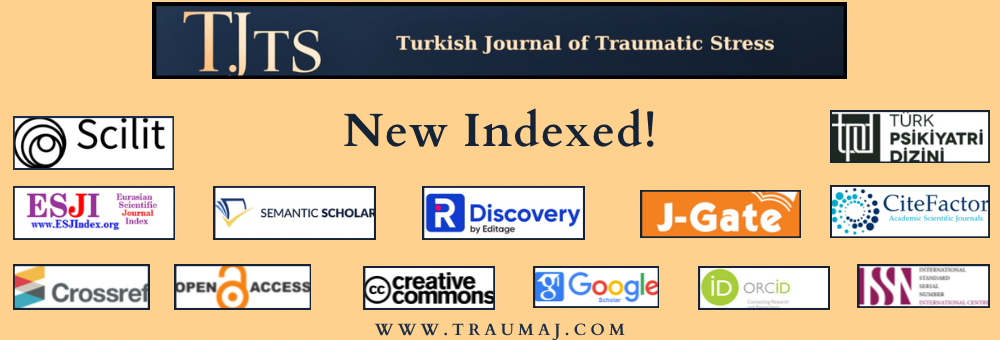The Association Between Obsessive Compulsive Symptoms, Childhood Traumas, and Dissociative Experiences
The Association Between Obsessive Compulsive Symptoms, Childhood Traumas, and Dissociative Experiences
DOI:
https://doi.org/10.63175/tjts.16Keywords:
Childhood traumas, Dissociative experiences, Obsessive Compulsive Symptoms, OCD, TraumaAbstract
Background: Obsessive compulsive symptoms (OCS), along with dissociative experiences (DE) are frequently acknowledged as coping strategies in individuals with childhood traumas (CT). Examining these relationships can highlight how early life traumatic events contribute to the emergence of psychopathologies in adulthood. In this study we aimed to investigate the associations between CT, OCS, and DE, and also examined whether DE and CT had a predictive value on OCS in a non-clinical sample of adults.
Methods: Three hundred eighty-eight participants (80.7% females, %83.8 university graduates, 55.4% married individuals) between the age of 18-66 years (M=29.09, SD=7.43 years) and with no current psychiatric diagnosis or treatment were evaluated via socio-demographic information form, Padua Inventory (PI), Dissociative Experiences Scale (DES) and Childhood Traumas Questionnaire (CTQ).
Results: Significant positive associations between CT, DE and OCS were observed. Multiple hierarchical regression analysis revealed CT and DE as predictors of adulthood OCS; and additionally, DE had a stronger predictive value with 28% of the variance whereas CTQ scores predicted approximately 3%.
Conclusion: Early life adversities may be related to emotional dysregulation, which could subsequently be associated with adult psychopathologies and dissociative experiences, suggesting a possible mediating pathway. In order to propose definite causal relations, future studies with longitudinal designs focusing particularly on the timing, duration, and subtypes of early trauma and the appearance of symptoms in adulthood are needed.
This article’s short podcast by AI (English)
This article’s short podcast by AI (Turkish)
References
1. Stein DJ, Locher C. Obsessive-Compulsive and Related Disorders. In: RJ Boland, ML Verduin eds. Kaplan and Sadock’s Comprehensive Textbook of Psychiatry Volume I, Eleventh Edition. Lippincott Williams & Wilkins. 2025;5727-5780
2. Destrée L, Brierley MEE, Albertella L, Jobson L, Fontenelle LF. Effect of childhood trauma on the severity of obsessive-compulsive symptoms: a systematic review. J Psychiatr Res. 2021;142:345-360.
3. Wang P, Zhao Q, Xu T, et al. Interaction between PGRN gene and early trauma on clinical characteristics in patients with obsessive-compulsive disorder. J Affect Disord. 2020;263:134-140.
4. Khosravani V, Sharifi Bastan F, Samimi Ardestani M, Jamaati Ardakani R. Early maladaptive schemas and suicidal risk in an Iranian sample of patients with obsessive-compulsive disorder. Psychiatr Res. 2017;255:441-448. doi:10.1016/j.psychres.2017.06.080
5. Kroska EB, Miller ML, Roche AI, Kroska SK, O’Hara MW. Effects of traumatic experiences on obsessive-compulsive and internalizing symptoms: the role of avoidance and mindfulness. J Affect Disord. 2018;225:326-336.
6. Rachman S. Cleaning damned spots from the obsessive mind. Nature. 2013;503(7):7. doi:10.1038/503007a
7. Kart A, Türkçapar H. The effects of childhood emotional abuse on aggressive obsessions among patients with obsessive compulsive disorder may be mediated by symptoms of depression and anxiety. Psychiatry Clin Psychopharmacol. 2019;29(4):411-417.
8. Semiz UB, Inanc L, Bezgin CH. Are trauma and dissociation related to treatment resistance in patients with obsessive-compulsive disorder? Soc Psychiatry Psychiatr Epidemiol. 2014;49(8):1287-1296.
9. Grisham JR, Fullana MA, Mataix-Cols D, Moffitt TE, Caspi A, Poulton R. Risk factors prospectively associated with adult obsessive–compulsive symptom dimensions and obsessive–compulsive disorder. Psychol Med. 2011;41(12):2495-2506.
10. Breet E, Kidd M, McGregor NW, Stein DJ, Lochner C. Suicide ideation and attempts in obsessive-compulsive disorder. Ann Clin Psychiatry. 2019;31(3):192-199.
11. Renkema TC, de Haan L, Schirmbeck F, et al. Childhood trauma and coping in patients with psychotic disorders and obsessive-compulsive symptoms and in un-affected siblings. Child Abuse Negl. 2020;99:104243.
12. Daniels JK, Timmerman ME, Spitzer C, Lampe A. Differential constellations of dissociative symptoms and their association with childhood trauma–a latent profile analysis. Eur J Psychotraumatol. 2024;15(1):2348345.
13. Vonderlin R, Kleindienst N, Alpers GW, Bohus M, Lyssenko L, Schmahl C. Dissociation in victims of childhood abuse or neglect: a meta-analytic review. Psychol Med. 2018:1-10. doi:10.1017/s0033291718000740
14. Wilgus SJ, Packer MM, Lile-King R, Miller-Perrin CL, Brand BL. Childhood emotional maltreatment and later psychological distress among college students: the mediating role of maladaptive schemas. Child Abuse Negl. 2016;33(1):59-68.
15. Kate MA, Jamieson G, Middleton W. Childhood sexual, emotional, and physical abuse as predictors of dissociation in adulthood. J Child Sex Abuse. 2021;30(8):953-976. doi:10.1080/10538712.2021.1955789
16. Wagner-Skacel J, Riedl D, Kampling H, et al. Mentalization and dissociation after adverse childhood experiences. Sci Rep. 2022;12:6809. doi:10.1038/s41598-022-10787-8
17. Buchnik-Daniely Y, Vannikov-Lugassi M, Shalev H, Soffer-Dudek N. The path to dissociative experiences: a direct comparison of different etiological models. Clin Psychol Psychother. 2021;28(5):1091-1102. doi:10.1002/cpp.
18. Betz LT, Penzel N, Rosen M, Kambeitz J. Relationships between childhood trauma and perceived stress in the general population: a network perspective. Psychol Med. 2021;51(15):2696-2706. doi:10.1017/S003329172000135X
19. Sanavio E. Obsessions and compulsions: the Padua Inventory. Behav Res Ther. 1988;26(2):169-177.
20. Beşiroğlu L, Ağargün MY, Boysan M, Eryonucu B, Güleç M, Selvi Y. The assessment of obsessive-compulsive symptoms: the reliability and validity of the Padua inventory in a Turkish population. Turk Psikiyatri Derg. 2005;16(3):179-189.
21. Bernstein DP, Fink L, Handelsman L, Foote J. Childhood Trauma Questionnaire (CTQ) [Database record]. APA PsycTests. 1994. doi:10.1037/t02080-000
22. Şar V, Öztürk PE, İkikardeş E. Çocukluk çağı ruhsal travma ölçeğinin Türkçe uyarlamasının geçerlilik ve güvenilirliği. Turkiye Klinikleri J Med Sci. 2012;32(4):1054-1063.
23. Bernstein EM, Putnam FW. Development, reliability, and validity of a dissociation scale. J Nerv Ment Dis. 1986;174(12):727-735.
24. Yargic LI, Tutkun H, Sar V. Reliability and validity of the Turkish version of the Dissociative Experiences Scale. Dissociation Disord. 1995;8(1):10-13.
25. Lin B, Ye Z, Ye Y, Wang K, Zhang Y. The effect of childhood emotional abuse and neglect on disturbed dreaming frequency: the important role of rumination and perceived social support. Dreaming. 2024;34(4), 318–327. https://doi.org/10.1037/drm0000270
26. Domke AK, Hartling C, Stippl A, et al. The influence of childhood emotional maltreatment on cognitive symptoms, rumination, and hopelessness in adulthood depression. Clin Psychol Psychother. 2023;30(5):1170-1178.
27. Barzilay R, Patrick A, Calkins ME, Moore TM, Gur RC, Gur RE. Association between early‐life trauma and obsessive compulsive symptoms in community youth. Depress Anxiety. 2019;36(7):586-595.
28. Richardson T, Egglishaw A, Sood M. Does childhood trauma predict impulsive spending in later life? An analysis of the mediating roles of impulsivity and emotion regulation. J Child Adolesc Trauma. 2024. doi:10.1007/s40653-023-00600-7
29. Badour CL, Tipsword JM, Jones AC, et al. Obsessive-compulsive symptoms and daily experiences of posttraumatic stress and mental contamination following sexual trauma. J Obsessive-Compuls Relat Disord. 2023;36:100767.
30. Brake CA, Tipsword JM, Badour CL. Mental contamination, disgust, and other negative emotions among survivors of sexual trauma: results from a daily monitoring study. J Anxiety Disord. 2021;84:102477.
31. Millar JF, Coughtrey AE, Healy A, Whittal M, Shafran R. The current status of mental contamination in obsessive compulsive disorder: a systematic review. J Behav Ther Exp Psychiatry. 2023;80:101745.
32. Çoban A, Tan O. Attention deficit hyperactivity disorder, impulsivity, anxiety, and depression symptoms mediating the relationship between childhood trauma and symptoms severity of obsessive-compulsive disorder. Arch Neuropsychiatry. 2020;57:37-43.
33. McGregor NW, Hemmings SMJ, Erdman L, Calmarza-Font I, Stein DJ, Lochner C. Modification of the association between early adversity and obsessive-compulsive disorder by polymorphisms in the MAOA, MAOB and COMT genes. Psychiatr Res. 2016;246:527-532.
34. Friedman E, Billick SB. Unintentional child neglect: literature review and observational study. Psychiatr Q. 2015;86(2):253-259. doi:10.1007/s11126-014-9328-0
35. Jackson AL, Frederico M, Cleak H, Perry BD. Interventions to support children’s recovery from neglect—a systematic review. Child Maltreat. 2023;28(4):627-642.
36. Perry BD, Winfrey O. What happened to you?: conversations on trauma, resilience, and healing. Unabridged. New York, NY: Flatiron Books; 2021.
37. Tonna M, Marchesi C, Parmigiani S. The biological origins of rituals: an interdisciplinary perspective. Neurosci Biobehav Rev. 2019;98:95-106.
38. Ojserkis R, McKay D, Kim S. Obsessive-compulsive symptom profiles in individuals exposed to interpersonal versus noninterpersonal trauma. Bull Menninger Clin. 2020;84(1):1-26.
39. Carlson EB, Putnam FW. An update on the Dissociative Experiences Scale. Dissociation. 1993;6(1):16-27.
40. Soffer-Dudek N, Lassri D, Shahar G. Dissociative absorption: an empirically unique, clinically relevant, dissociative factor. Conscious Cogn. 2015;36:338-351.
41. Pozza A, Dèttore D. “Was it real or did I imagine it?” Perfectionistic beliefs are associated with dissociative absorption and imaginative involvement in obsessive-compulsive disorder. Psychol Res Behav Manag. 2019;12:603-607. doi:10.2147/PRBM.S212983
42. Soffer‐Dudek N. Dissociative absorption, mind‐wandering, and attention‐deficit symptoms: associations with obsessive‐compulsive symptoms. Br J Clin Psychol. 2019;58(1):51-69.
43. Debnath A, Sarkar S. Impact of early life stress on neurobiological vulnerability to obsessive-compulsive disorder: early life stress & neurobiological OCD risk. Brain Sci Adv. 2024;10(2). doi:10.26599/BSA.2024.905005
44. Jalal B, Chamberlain SR, Sahakian BJ. Obsessive‐compulsive disorder: etiology, neuropathology, and cognitive dysfunction. Brain Behav. 2023;13(6):e3000.
45. Robbins TW, Banca P, Belin D. From compulsivity to compulsion: the neural basis of compulsive disorders. Nat Rev Neurosci. 2024;25(5):313-333.
46. Sideli L, Santoro G, Fontana A, Guglielmucci F, Caretti V, Schimmenti A. The relationship between obsessive-compulsive symptoms and dissociation: a systematic review and meta-analysis. J Trauma Dissociation. 2023;24(3):362-379.
47. American Psychiatric Association. Diagnostic and statistical manual of mental disorders: DSM-5. 5th ed, Vol 5. Washington, DC: American Psychiatric Association; 2013.
48. Vannikov‐Lugassi M, Shalev H, Soffer‐Dudek N. From brooding to detachment: rumination longitudinally predicts an increase in depersonalization and derealisation. Psychol Psychother. 2021;94:321-338.
49. Schulze A, Hughes N, Lis S, Krause-Utz A. Dissociative experiences, borderline personality disorder features, and childhood trauma: generating hypotheses from data-driven network analysis in an international sample. J Trauma Dissociation. 2024;1-20.
50. Katzman W, Papouchis N. Effects of childhood trauma on mentalization capacities and dissociative experiences. J Trauma Dissociation. 2023;24(2):284-295. doi:10.1080/15299732.2023.2168829
51. Forner C. What mindfulness can learn about dissociation and what dissociation can learn from mindfulness. J Trauma Dissociation. 2019;20(1):1-5. doi:10.1080/15299732.2018.1502568
52. Lanius RA. Trauma-related dissociation and altered states of consciousness: a call for clinical, treatment, and neuroscience research. Eur J Psychotraumatol. 2015;6(1):27905.
53. Ojalehto H, Abramowitz J, Hellberg S, Buchholz J, Twohig M. Adherence to exposure and response prevention as a predictor of improvement in obsessive-compulsive symptom dimensions. J Anxiety Disord. 2020;72:102233.
54. Philip J, Cherian V. Acceptance and commitment therapy in the treatment of obsessive-compulsive disorder: a systematic review. J Obsessive-Compuls Relat Disord. 2021;28:100603. doi:10.1016/j.jocrd.2020.100603
55. Soondrum T, Wang X, Gao F, Liu Q, Fan J, Zhu X. The applicability of acceptance and commitment therapy for obsessive-compulsive disorder: a systematic review and meta-analysis. Brain Sci. 2022;12(5):656. doi:10.3390/brainsci12050656
56. Pittenger C, Kelmendi B, Wasylink S, et al. Riluzole augmentation in treatment-refractory obsessive-compulsive disorder: a series of 13 cases, with long-term follow-up. J Clin Psychopharmacol. 2008;28(3):363-367. doi:10.1097/JCP.0b013e3181727548
Published
How to Cite
Issue
Section
License
Copyright (c) 2025 Bengü Sare Sevda Pelin Kılıç, Feryal Çam Çelikel, Selin Karaköse, Önder Kavakçı

This work is licensed under a Creative Commons Attribution 4.0 International License.








